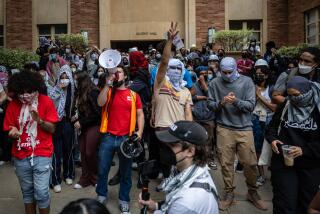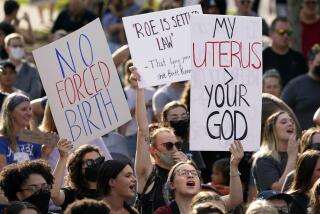Peace Movement in the Heartland Includes Activists, Issues, Government : Protest: The result is like a patchwork quilt, divergent pieces for peace. The Iowa Legislature even kicked in $287,000 to fund an institute.
- Share via
GRINNELL, Iowa — In the heart of America, supposed bastion of Richard Nixon’s silent majority during the Vietnam War, the peace movement has grown into a vast patchwork quilt, a piece here, a piece there. Each is different but all are united in a desire to make a better world. Even the Iowa Legislature has contributed to the cause.
Tempered by the three decades of social upheaval since the first American soldier went to Southeast Asia, the anti-war movement can no longer be viewed as a monolith of irreverent demonstrators. It has become many things to many people.
There is no stereotypical “peacenik” anymore, no fountainhead on any one college campus or in any one city. There are grandmothers and high school scholars, bankers and military dependents, working in their own ways for their own visions.
And not everyone who is for peace is against war, at least not against the Persian Gulf War.
Americans learned hard and lasting lessons from Vietnam, not only about Asian killing fields but also about brutality in Chicago during the 1968 Democratic Convention, the shootings of students at Kent State and Jackson State, the institutional lying and cover-ups during Watergate.
Since those days of rage, there also have sprung up in American life deep concerns about the environment, nuclear arms, sex and race discrimination, apartheid in South Africa, death squads in Latin America, the bankruptcy of the family farm, the savings and loan crisis, homelessness and a bloated national debt.
“The peace movement didn’t end when the Vietnam War ended,” said Lisa Fithian, co-coordinator of the Washington Peace Center. “People put their energy into a whole range of issues--elderly organizations, housing, health care, women’s issues. You name it, and the peace movement people got involved.”
In Iowa, just as in most of the rest of the country, objections to the Gulf War did not ring out from a vast chorus, marchers did not shake the earth in lock step. Flag-burning was not in fashion.
Still there was dissent, on the farm and in the stores, at the lunch counter and in the board room.
Iowa activists long have overlapped and fed off each others’ databases. Now, linked by computer bulletin boards and fax machines, they can unite quickly behind a common cause. Opposing the Gulf War became a rallying point for many who, during peacetime, focused on issues such as banning pesticides and saving whales.
“The peace movement cannot exist in a vacuum,” said Iowa state Sen. Jean Lloyd-Jones, a founder of the taxpayer-supported Iowa Peace Institute. “It is the women’s movement, the environmental movement, the nuclear freeze movement, and all those other things that concern us. Everything contributes to the wellness of the planet.”
The Iowa Peace Institute, based in this college town 50 miles east of Des Moines, was founded in 1987. It gets funds from corporations, foundations, individuals and the Iowa Legislature, which this year kicked in $287,000. It is the only peace institute supported by a legislature.
“IPI sees itself as part of the mainstream, and that is what we want,” said its director, former Lt. Gov. Bob Anderson.
The Gulf War galvanized the movement in the state. Volunteers flocked to draft-counselor training sessions; 100 people attended one recent session. Letter-writing campaigns to Congress were launched; clusters of protesters assembled for candlelight prayer vigils; phone banks were organized for future rallies; in some counties, letters to the editor about the war ran 50-50.
“But most people are defining that if they are against the war, they are for the troops,” said Denise O’Brien, a board member of the National Family Farm Coalition who has a dairy farm with her husband near Atlantic, Iowa.
“There’s great sensitivity to that. The Vietnam experience taught us that we don’t want troops to be condemned for policy,” she said.
After the eruption of protests at the war’s start, which included a march of 75,000 people in Washington and a rally of 20,000 in San Francisco, the peace movement was a collection of candlelight vigils and prayer meetings scattered across the country, of small gatherings in front of courthouses and post offices.
At the core of the demonstrations were veterans of the Vietnam protests. They had gone on with their lives during the 1970s and 1980s, “had children, worked at their jobs,” said Fithian of the peace center in the nation’s capital.
“But when you have a crisis of this magnitude, many people again become active who were otherwise dormant,” she said.
On Feb. 23, the day the ground war began, about 400 people from around the country gathered at a Washington church to plan further protests. Anti-war protest leader Daniel Ellsberg was one of them.
“I got up and thanked all these people who are part of the peace community, part of my extended family, who worked against the Vietnam War and the arms race, against racial and sex discrimination, against atrocities in Central America,” Ellsberg said. “Then I told them that a community needs rituals, and one of our rituals is demonstrations. We must continue to demonstrate.”
Peace activists said their message was muted by the rapid pace of the Gulf War and its relatively short duration. Had the allies become bogged down in a long, bloody conflict causing heavy American casualties, as in Vietnam, calls for peace would have grown louder, they said.
Here in Iowa, one anti-war rally attracted 2,000 people; a rally in support of the war drew 1,000. The majority were silent six weeks into America’s 10th war, quiet and watching, waiting for what would come next.
Iowa’s peace movement swings from diverse compass points, reflecting the national trend. Community groups such as the United Nations Assn. and Beyond War work alongside traditional churches and little-known organizations such as People for Middle East Peace, the Central Iowa US-USSR Friendship Committee and the fledgling Skunk Valley Peace Committee.
Business for Peace was founded in 1987 by a few corporate chief executives who, according to a brochure, “share a common belief that the overriding concerns in today’s world are the increasing reliance on military force and the threat of nuclear war.”
The pivotal organizer was G. David Hurd, president of The Principal Financial Group, one of the nation’s largest insurance firms.
“We’re not much for rallies or demonstrations or emotional things, but we try (to) study issues, and we believe peace is developed by relationships with people,” said Bob Larson, the group’s administrator in Des Moines.
Larson said Business for Peace has about 150 members, of whom 30 or 40 are CEOs. It includes officers of the Maytag Corp., seed corn giant Pioneer Hi-Bred International and communications conglomerate Meredith Corp.
Many war opponents say they resent being labeled unpatriotic or disloyal to their country.
“I think (that) most people have a very narrow definition of peace, that in the United States being for peace is perceived as being opposed to everything the government is doing, and has a subversive air about it,” said Anderson of the Iowa Peace Institute.
Laura Wieman, 77, is a veteran of half a century of social change. Her late husband, Henry Nelson Wieman of the University of Chicago, was one of the nation’s foremost theologians and the subject of Dr. Martin Luther King Jr.’s Ph.D. dissertation. Born and reared in Grinnell, she returned here to live in her parents’ house and help to found Peace Network, a group of 12 that coordinates efforts among organizations.
Her life today revolves around local activism, whether it’s teaching English to Cambodian refugees or feeding hungry pilgrims on a nationwide march.
“In Iowa, the peace movement goes around in a big circle,” said Wieman. “It has been that way since pioneer times, and I can’t ever see it changing. There has never been one leader. That’s the beauty of it. We are all trying to do our part in our own little corners.”
More to Read
Sign up for Essential California
The most important California stories and recommendations in your inbox every morning.
You may occasionally receive promotional content from the Los Angeles Times.













